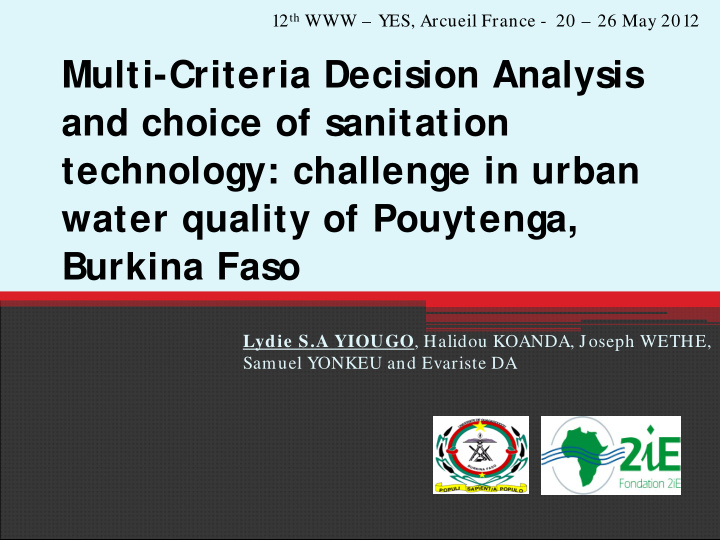



12 th WWW – YES, Arcueil France - 20 – 26 May 2012 Multi-Criteria Decision Analysis and choice of sanitation technology: challenge in urban water quality of Pouytenga, Burkina Faso Lydie S.A YIOUGO , Halidou KOANDA, Joseph WETHE, Samuel YONKEU and Evariste DA
OUTLINE • Introduction • Material & Methods • Definition of MultiCriteria Decision Analysis • Methodogogy of MCDA implementation • Outcomes • Ranking of sanitation technology options according to Household Standard of Living (HSL) • Ranking of sanitation technology options according to gender • Stakeholders coalition analysis • Conclusion
Introduction S tudy context • This study is part of phD research on « Sustainable Sanitation in mid-size cities in Sub Saharan Africa » • Global aim: To develop methods and tools for sustainable sanitation planning. • Mains Steps:
Introduction Sanitation status (Yiougo et al., 20 11) -Discharges of material and pollutant in water resource (about 435,000 tons of material, including 318 tons of nitrogen per year) -rainwater is drained by natural channels and discharges into a dam; -dam is used for supplying the city with drinking water. Pouytenga • 72 000 inhabitants There is a need to protect Water • Climate: rainfall � 753 mm quality for drinking water supply •Temperature � 24°C – 41°C
Introduction • To protect water quality � To solve sanitation issues � To develop and implement a Sanitation Strategic Plan (SSP). • To draw a SSP for solid and liquid wastes, several technologies exist � What’s tool to support decision? • Participatory decision-making process is a key of SSP implementation success. • This process brings together people with diverse set of interests in an open, authentic discussion of possible solutions in order to arrive at a mutual beneficial solution.
Material & Methods Global aims � to apply a decision-making model for the choice of sanitation options technology in Pouytenga, a mid-size city in Africa Global Methodology � MultiCriteria Decision Analysis (MCDA) • Multi-criteria analysis is a decision-making tool that supports solution of complex multi-criteria problems which include qualitative and/ or quantitative parameters in decision-making • MCDA allow choosing the most optimal choice among several options or alternatives, where option A scores better than option B with regard to some objectives, but worse on others • MCDA implies that several actors are included in the process of decision making in order to legitimize the decision and to ensure collective ownership of its implementation.
Stakeholders Material & Methods
Material & Methods Possible alternatives or options Issues Actions or alternatives - Standpipe Drinking water supplying - Network connection - dustbin solid waste management - Door to door collection - Recovery and recycling - soak away Wastewater management - Septic tank Excreta management - Pour -flush toilet - Ventilated improved Pit (VIP) - Urine Diverted Toilet (UDT) - Mechanical emptying Faecal sludge management - Manual emptying - Sludge treatment and reuse - Channel construction Rainwater management - Channel cleaning out
Criteria Material & Methods
Material & Methods Data collection: •Household survey among 60 households (20 households of low standard of living, 20 medium and 20 from high) •Focus groups with 02 groups: a group of men and a women's group. •Workshop •Weighting of issues: This involves distribution of 100 points on 07 issues •Weighting of the criteria: This also involves the distribution of 100 points on four criteria •The willingness to pay for the options or alternatives.
Outcomes Ranking of sanitation technology options according to HSL Low standard � Mid-standard � The ranking of Decision-making options is is shared motivated between the primarily by the criteria strategy strategy cost cost and service criterion quality High standard � The decision axis of household of high standing is mainly directed towards the criterion of service quality
Outcomes Ranking of sanitation technology options according to gender Sanitation technology options ranking which were derived during the focus groups did not show a significant difference between the ranking of men and women. The ranking is similar to that obtained in the household’s survey of low and medium standard of living households
Outcomes Stakeholders coalition analysis Decision axis
Outcomes Stakeholders coalition analysis On the basis that the 03 categories of stakeholders have the same power of decision, a ranking of stakeholder’s coalition has been done: -Drinking water � increase of standpipe’s number of individual connections -Solid waste � in addition to the waste collection system, a system for recycling and waste recovery. -Excreta � UDT, VIP and pour-flush toilet. -Fecal sludge � Manual emptying.
Conclusion • Criteria of environmental sustainability and socio- cultural acceptability are not involved much in the process of decision-making. • Criteria that guided the decisions are those relating to strategy costs and service quality • One of the key success factors of a multi-criteria analysis is the effective participation of those concerned and careful choice of the criteria guiding the choice of technologies.
Conclusion • The MCA is based on the weighting of criteria, so the choice is made without the stakeholders being aware of options which they have chosen, hence the need to achieve restitution and validation workshop • In this study, some selected options were abandoned in favour of other in view of their disadvantages. • One parameter to take into account is also representative of each group of stakeholder.
Study supported by :
Recommend
More recommend